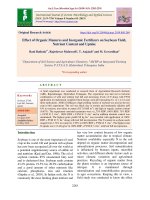Consequence of fym and fly ash application on yield, nutrient uptake, and quality of safed musli grown on Inceptisols
Bạn đang xem bản rút gọn của tài liệu. Xem và tải ngay bản đầy đủ của tài liệu tại đây (361.6 KB, 11 trang )
Int.J.Curr.Microbiol.App.Sci (2019) 8(5): 263-273
International Journal of Current Microbiology and Applied Sciences
ISSN: 2319-7706 Volume 8 Number 05 (2019)
Journal homepage:
Original Research Article
/>
Consequence of Fym and Fly Ash Application on Yield, Nutrient Uptake,
and Quality of Safed Musli Grown on Inceptisols
Payal B. Hadke*, S.G. Wankhade and Sagar N. Ingle
Department of Soil Science and Agril. Chemistry, Dr. Panjabrao Deshmukh Krishi
Vidyapeeth, Akola- 444104, India
*Corresponding author
ABSTRACT
Keywords
FYM, Fly-ash,
Safed Musali,
Saponin
Article Info
Accepted:
04 April 2019
Available Online:
10 May 2019
Effect of FYM and fly ash application on yield, content, uptake and quality of safedmusali in Inceptisols was investigated in field experiment carried out on clayey soil at
Nagarjun Medicinal Plants Garden, Dr. Panjabrao Deshmukh Krishi Vidyapeeth, Akola
(M.S.). There were three levels of FYM and four levels of fly ash with three replications
tried in Factorial randomised block design. The results obtained in the present
investigation showed that, the number of leaves per plant and leaf area of Safed musli were
non significantly influenced due to application of Fly ash. No significant effect of FYM
application was also noticed on number of leaves. However, leaf area was significantly
influenced with the application of FYM upto 10 t FYM ha -1. The fresh as well as dry root
yield was significantly recorded highest with the application of 20 t FYM ha -1. The highest
safed musli root yield was also recorded with the application of fly ash 15 t ha-1. However,
it was at par with 10 t and 5 t ha-1 Fly ash applications. The content and uptake of
nutrients, were also significantly influenced with the application of FYM and fly ash. The
saponin content and yield and protein content of Safed musli roots were significantly
increased with 20 t FYM ha-1. The significantly highest saponin content and yield and
protein content also recorded with 15 t Fly ash ha-1. However, it was at par with 10 and 5 t
fly ash levels.
(Akola) and Jalgaon Jamod (Buldhana). This
species has low rate of regeneration due to
shy flowering and poor setting of viable seed.
It may thus become rare and may be lost from
the habitat if the large scale collection in
forest continues at the present rate (Bordia,
1992).
Introduction
Safed musli (Chlorophytum borivililanum) is
an important medicinal perennial herb,
belongs to family Liliaceae, widely
distributed in India and found in hilly regions
of Himalay, Satpuda, Vindhay, Aravuli and in
hilly area of Bihar and Assam. It is also found
in the part of Rajasthan and Gujarat. In
Maharashtra, particularly, in Vidarbha, safed
musli found widely in the forest of Melghat,
Chikhaldara and Satpuda hills nearby Akot
The fasciculated root of this herb has great
medicinal values mainly due to its saponin
content and is used extensively in Ayurvedic
medicines. The roots also having aphrodisiac
263
Int.J.Curr.Microbiol.App.Sci (2019) 8(5): 263-273
properties and therefore it is an important
ingredient of herbal tonic to cure general
debility and male sterility (Kirtikar and Basu,
1975). Bordia et al., (1995) reported that the
major constituents of safed musli are
carbohydrates (42%), protein (8-9%), root
fibres (3-4%) and saponin (2-17%). Presently,
the root fetches an attractive price in the
market, which is mainly determined by the
size and colour of the roots and its physical
appearance. For obtaining good quality roots,
the plant growth medium should be porous
with optimum fertility status. In that context;
the application of FYM and fly ash might be
best source for improving physical properties
of soil as well as provide nutrients to the crop.
attracts the agriculture scientists for its
utilization in improving crop and soil
productivity.
A part from nutrition fly ash generation is
expected to increase to 300 million tons per
annum by 2017 and 900 million tons per
annum by 2031-32 (Planning Commission,
2014) it is a fine, grey, amorphous powder
and rich in Si, Al, spherical in shape having
excellent physical properties.
The physic-chemical properties of fly ash
may vary widely, depending upon the nature
of the coal, the efficiency of the coal
combustion process and the selection process.
It is similar to soil in some of physical and
chemical properties, as it contains major,
secondary and trace elements, which are
found in earth crust. Total major nutrients N
and P were low i.e. 0.056 and 0.087 %,
respectively, but it contains sufficient by
higher amount of total K (0.172%), CaO
(1.60%), MgO (0.96%) and total trace
elements i.e. Mn 3.98 ppm, Cu 3.60 ppm, Zn
1.30 ppm and Fe 3.81 ppm, respectively
(Bhoyer, 1998).
Productivity is greatly influenced by the
pattern of rainfall distribution, soil type, soil
nutrient status, temperature and climatic
factors. The high cost of fertilizer and low
purchasing capacity of the small and marginal
peasants of the country which restrict the use
of costly fertilizer inputs.
About 130 coal-based thermal power stations
in India are producing over165 million tons
fly ash per year (CEA report 2014). With the
increasing demand of power, more thermal
power stations are expected to be
commissioned or increase expected in their
existing capacity (Mukherjee and Vesmawala,
2013).
Presence of organic matter in soil has an
additive effect as it reduces the concentration
of toxic metals through sorption, lowers the
C/N ratio and provides organic compounds,
which promote microbial proliferation and
diversity (Wong and Wong, 1986; Pitchel and
Hayes, 1990).
Fly ash is a by-product of the Thermal Power
Station, where coal energy is converted into
electrical energy. The demand for electrical
energy is increasing day by day and in the
absence of its utilization of the byproduct of
thermal plant, it is been getting accumulated
and for storing large area of arable land will
be required which is therefore finding
immediate use of fly ash for different
purposes is very important. Fly ash being an
inert heterogeneous SiO2, Al2O3 and Fe2O3 as
a main components and material containing
mineral nutrients as minor components which
In combination with various organic manure,
fly ash can enhance soil microbial activities,
nutrient availability and plant productivity
(Sikka and Kansal, 1995). Keeping in view
the above facts, it an investigation
entitled “Consequence of FYM and Fly ash
application on the yield, nutrient uptake and
quality of Safed musli grown on
Vertisol”. was carried out during the year
2013-14.
264
Int.J.Curr.Microbiol.App.Sci (2019) 8(5): 263-273
Materials and Methods
Statistical analysis
A field experiment was conducted during
2013-14 at Nagarjun Medicinal Plants
Garden, Dr. Panjabrao Deshmukh Krishi
Vidyapeeth, Akola (M.S.). There were three
levels of FYM and four levels of fly ash with
three replications tried in Factorial
randomised block design located at between
220 41‟ N latitude and 770 02‟ longitudes at an
altitude of 307.4 m above mean sea level and
has a subtropical climate.The soil of the
experimental site was clayey in nature with
pH 8.2 (1:2 soil: water) (Piper, 1996), low in
Ec (Piper, 1996), low in organic matter
content of 0.5% (Jackson, 1967), low in
available N (Kjeldah‟s method) (Subbiah and
Asija, 1956), low in available P (Jackson,
1967) and medium in available K (Jackson,
1967) at the start of experiment.
Standard method of analysis known as
„Analysis of Variance‟ was applied for the
standard analysis of the data, critical
difference (CD) at 5 percent level of
significance was worked out and use for
comparison of different treatment (Gomez
and Gomez, 1984).
Results and Discussion
Effect of FYM and fly ash on number of
leaves, leaf area
Under growth studies, observations on
different growth parameters such as number
of leaves, leaf area and dry matter
accumulation, indicated that the overall
growth was found to be increased due to
application of FYM and fly ash at various
levels. Regarding the effect of FYM on leaf
area, the data presented in (Table 1). showed
that the effect of FYM on leaf area was found
to be significant at 30, 60 and 90 DAP.
Significantly highest leaf area was recorded
with the application of 20 t FYM ha-1 (M2)
followed by application of 10 t FYM ha-1
(M1).This might be due to availability of plant
nutrients in addition to improvement in
porosity, infiltration through organic manures,
resulted into the increased leaf area
significantly. The similar results were also
reported by Bordia et al., (1995), and Sharma
(1996). On the contrary, the fly ash levels had
non-significant effect on leaf area recorded
during all the growth stages under study
except at 60 DAP and significantly highest
leaf area (29.56 cm2) was recorded with the
application of 15 t fly ash ha- 1 which was at
par with 10 t fly ash ha-1 (F2) and 5 t fly ash
ha-1 (F1).The incorporation of fly ash in soil
was found to be helpful for crop/plant growth
was also reported by several workers
Warambhe et al., (1991), Jambagi (1995) and
Bhople (2006)
The experiment was laid out in a Factorial
Randomized Block Design (FRBD) on the
same site with three replications having
twelve treatment combinations, that is, T1
(control), T2 FYM (0 t ha-1) + Fly ash (5 t
ha-1), T3 (FYM (0 t ha-1) + Fly ash (10 t ha-1),
T4 FYM (0 t ha-1) + Fly ash (15 t ha-1), T5
FYM (10 t ha-1) + Fly ash (0 t ha-1), T6 FYM
(10 t ha-1) + Fly ash (5 t ha-1)T7 FYM (10 t
ha-1) + Fly ash (10 t ha-1),T8 (FYM (10 t ha-1)
+ Fly ash (15 t ha-1)T9FYM (20 t ha-1) + Fly
ash (0 t ha-1) T10FYM (20 t ha-1) + Fly ash (5
t ha-1) T11 FYM (20 t ha-1) + Fly ash (10 t
ha-1) and T12FYM (20 t ha-1) + Fly ash (15 t
ha-1). Planting sprouted roots of Safed musli
were used for planting. Two roots bunch was
planted at 30 x10 cm spacing on raised beds.
The growth observations viz., number of
leaves and leaf area were recorded upto 90
days. As after 90 days defoliation of the plants
usually occurred in Safed musli. The
observations on fresh and dry weight of roots,
number of leaves, leaf area and dry matter
accumulation at 30, 60, 90 days were
recorded.
265
Int.J.Curr.Microbiol.App.Sci (2019) 8(5): 263-273
Effect of FYM and fly ash on dry matter
accumulation of plant and roots
Effect of FYM and fly ash on root yields
Application of various levels of FYM and fly
ash recorded increased fresh and dry root
weight (g plant-1), fresh and dry root yield of
Safed musli. The data presented in (Table 3).
The significantly highest root yield was
noticed with the application of 20 t FYM ha-1
and 15 t fly ash ha-1 alone. However, the
difference in root yield due to application of
5, 10 and 15 t ha-1 were found non significant.
The interaction effect of FYM and fly ash on
root yield of Safed musli was found non
significant. Because of that the use of 10-15
tonnes of FYM ha-1 resulted in healthy plant
growth ultimately produced highest root yield
might be due to the good nutrient status of the
substratum similar were closely confirmative
by (Bordia et al., 1995).
The data presented in (Table 2). The dry
matter accumulation by plants was non
significantly influenced with the application
of FYM except at 60 days after planting.
Significantly highest dry matter accumulation
was recorded with the application of 20 t
FYM ha-1, however, it was at par with 10 t
FYM ha-1. Whereas, as dry matter
accumulation by roots was found significantly
influenced with the application of different
levels of FYM at 60 and 90 days after
planting. The dry matter accumulation was
significantly highest with the application of
20 t FYM ha-1 however, it was at par with 10 t
FYM ha-1 at 60 DAP. The significant effect of
FYM application on dry matter accumulation
might be due to the supply of balanced
nutrients to the crop plants. The dry matter
accumulation rate was found rapid to very
rapid from 30 days growth period upto 60
days, which was on account of increased
number of leaves and leaf area. During the
growth period of 85 to 90 days, the
defoliation started in the crop plant may be
the reason for non significant result of FYM
application on dry matter accumulation
similar results were closely paint by Paturde
et al., (2002) while fly ash had significant
effect on dry matter accumulation at 60 DAP
by plants and at 60 and 90 DAP by roots.
Effect of FYM and fly ash on quality and
protein content of safed musli roots
The saponin content and yield were
significantly increased with the FYM
application and highest values were recorded
with 20 t FYM ha-1. The significantly highest
saponin content and yield was also recorded
with 15 t fly ash ha-1. The significantly
highest content of protein was recorded with
the application of 20 t FYM ha-1 followed by
10 t FYM ha-1. The protein content was also
increased with the application of fly ash at
various levels, however, the differences
among the levels were non significant. The
data presented in (Table 4). Besides major
nutrients
the
FYM
also
contains
micronutrients in considerable amount which
might have supplied balanced nutrition to the
crop plant, which might have resulted in
better synthesis of secondary metabolites and
increased the saponin content and yield.
Similar results were also reported by Bordia
et al., (1990), Seth et al., (1991) and
Wankhade et al., (2004).
The highest biomass accumulation was
observed with 15 t fly ash ha-1 (F3) which was
at par with 10 t fly ash ha-1 (F2) and 5 t fly
ash ha-1 (F1). Whereas, the dry matter
accumulation by roots and plants was non
significant at 30 DAP and dry matter
accumulation by plants at 90 DAP During the
growth period of 85 to 90 days, the
defoliation started in the crop plant may be
the reason for non significant results of fly
ash application on dry matter accumulation.
266
Int.J.Curr.Microbiol.App.Sci (2019) 8(5): 263-273
Table.1 Number of Leaves plant-1 and Leaf area plant-1 (cm2) as influenced by FYM and fly ash
application
Treatments
No. of leaves
Days After planting
30
60
90
FYM levels (t ha-1)
9.92
16.00
M0 (0)
10.25
15.75
M1 (10)
10.92
15.75
M2 (20)
0.38
0.26
SE(m)±
NS
NS
CD at 5%
-1
Fly ash levels (t ha )
9.89
15.44
F0 (0)
10.00
16.33
F1 (5)
10.89
16.11
F2 (10)
10.67
15.44
F3 (15)
0.44
0.30
SE(m)±
NS
NS
CD at 5%
Interaction effect (FYM x Fly ash)
0.75
0.52
SE(m)±
NS
NS
CD at 5%
Leaf area
Days After planting
30
60
90
14.08
15.42
15.92
0.23
NS
22.33
23.58
23.25
0.30
0.88
27.58
29.42
30.17
0.21
0.60
25.58
27.33
27.33
0.28
0.83
14.11
15.22
15.44
15.78
0.27
NS
23.00
23.22
23.00
23.00
0.35
NS
28.33
29.00
29.33
29.56
0.24
0.69
26.56
26.44
27.00
27.00
0.33
NS
0.46
NS
0.60
NS
0.41
NS
0.57
NS
Table.2 Dry Matter accumulation (q ha-1) as influenced by FYM and fly ash application
Treatments
Plant Leaf biomass
Days after planting
30
60
90
FYM levels (t ha-1)
1.28
M0 (0)
1.32
M1 (10)
1.34
M2 (20)
0.01
SE(m)±
NS
CD at 5%
-1
Fly ash levels (t ha )
1.30
F0 (0)
1.32
F1 (5)
1.33
F2 (10)
1.31
F3 (15)
0.01
SE(m)±
NS
CD at 5%
Interaction effect (FYM x Fly ash)
0.03
SE(m)±
NS
CD at 5%
Root biomass
Days after planting
30
60
90
1.58
1.63
1.64
0.01
0.03
1.47
1.53
1.60
0.04
NS
2.84
3.02
3.16
0.10
NS
2.88
3.78
3.88
0.11
0.33
3.61
4.85
6.34
0.08
0.24
1.59
1.62
1.62
1.65
0.01
0.03
1.53
1.55
1.54
1.52
0.04
NS
2.94
3.00
3.05
3.04
0.12
NS
3.24
3.26
3.76
3.79
0.13
0.38
4.42
4.99
5.1
5.23
0.09
0.27
0.02
NS
0.08
NS
0.2
NS
0.22
NS
0.16
NS
267
Int.J.Curr.Microbiol.App.Sci (2019) 8(5): 263-273
Table.3 Root yield of safed musli as influenced by FYM and fly ash application
Treatments
FYM levels (t ha-1)
M0 (0)
M1 (10)
M2 (20)
SE(m)±
CD at 5%
Fly ash levels (t ha-1)
F0 (0)
F1 (5)
F2 (10)
F3 (15)
SE(m)±
CD at 5%
Interaction effect (FYM x Fly ash)
SE(m)±
CD at 5%
Fresh wt of
root
(g plant-1)
Dry wt of root
(g plant-1)
Fresh wt of
root (q ha-1)
Dry wt of
root
(q ha-1)
9.95
12.79
16.18
0.18
0.54
1.81
2.32
2.94
0.03
0.10
24.00
30.83
39.00
0.44
1.30
4.36
5.60
7.09
0.08
0.24
11.80
13.08
13.35
13.65
0.21
0.62
2.15
2.38
2.43
2.48
0.04
0.11
28.46
31.55
32.19
32.91
0.51
1.50
5.17
5.74
5.85
5.98
0.09
0.27
0.37
NS
0.07
NS
0.89
NS
0.16
NS
Table.4 Quality of safed musli roots as influenced by FYM and fly ash application
Treatments
FYM levels (t ha-1)
M0 (0)
M1 (10)
M2 (20)
SE(m)±
CD at 5%
Fly ash levels (t ha-1)
F0 (0)
F1 (5)
F2 (10)
F3 (15)
SE(m)±
CD at 5%
Interaction effect (FYM x Fly ash)
SE(m)±
CD at 5%
Saponin content (%)
Saponin yield (kg ha-1)
Protein content
(%)
7.19
7.97
8.11
0.01
0.03
31.45
44.72
57.48
0.64
1.88
7.93
8.22
8.50
0.06
0.18
7.57
7.70
7.76
8.00
0.01
0.03
39.96
44.48
45.61
48.16
0.74
2.17
8.04
8.26
8.23
8.33
0.06
0.19
0.03
0.08
1.28
3.75
0.11
NS
268
Int.J.Curr.Microbiol.App.Sci (2019) 8(5): 263-273
Table.5 Nitrogen (%) content and uptake in plant and root as influenced by FYM and fly ash application
Treatments
Nitrogen content in
Nitrogen content in
Nitrogen uptake by
Nitrogen uptake
plants
roots
plants
by roots
Days after planting
Days after
Days after planting
Days after
Days after
planting
Planting
planting
FYM levels (t ha-1)
Total uptake
30
60
90
30
60
90
30
60
90
30
60
90
30
60
90
M0 (0)
2.09
1.79
1.74
2.82
2.12
1.66
5.92
5.06
2.57
8.00
6.11
5.96
13.92
11.17
8.53
M1 (10)
2.36
1.86
1.81
3.03
2.33
1.74
7.13
5.63
2.76
9.17
8.92
8.42
16.3
14.55
11.18
M2 (20)
2.67
1.94
1.86
3.20
2.50
2.00
8.41
6.20
2.96
10.10
9.71
12.68
18.51
15.91
15.64
SE(m)±
0.05
0.01
0.01
0.02
0.06
0.07
0.31
0.08
0.07
0.32
0.38
0.35
0.63
0.46
0.42
0.14
0.03
0.03
0.06
0.17
0.21
0.90
0.24
0.20
0.92
1.11
1.03
1.82
1.35
1.23
F0 (0)
2.34
1.84
1.79
2.98
2.28
1.73
6.92
5.40
2.74
8.77
7.50
7.74
15.69
12.9
10.48
F1 (5)
2.37
1.86
1.80
3.01
2.31
1.79
7.13
5.63
2.79
9.06
7.71
9.07
16.19
13.34
11.86
F2 (10)
2.38
1.86
1.80
3.04
2.34
1.83
7.27
5.65
2.78
9.27
8.82
9.49
16.54
14.47
12.27
F3 (15)
2.40
1.88
1.81
3.05
2.35
1.83
7.31
5.83
2.75
9.28
8.96
9.77
16.59
14.79
12.52
SE(m)±
0.06
0.01
0.01
0.02
0.07
0.08
0.35
0.10
0.08
0.36
0.44
0.41
0.71
0.54
0.49
CD at 5%
NS
NS
NS
NS
NS
NS
NS
0.28
NS
NS
NS
1.19
NS
NS
NS
SE(m)±
0.10
0.02
0.01
0.04
0.12
0.15
0.61
0.16
0.13
0.63
0.76
0.70
1.24
0.92
0.83
CD at 5%
NS
NS
NS
NS
NS
NS
NS
NS
NS
NS
NS
NS
NS
NS
NS
CD at 5%
-1
Fly ash levels (t ha )
Interaction effect (FYM x
Fly ash)
269
Int.J.Curr.Microbiol.App.Sci (2019) 8(5): 263-273
Table.6 Phosphorous content and uptake (kg ha-1) by safed musli as influenced by FYM and Fly ash application
Treatments
Phosphorous
Phosphorous
content in plants
content in
Phosphorous
Phosphorous uptake
Total uptake
by root
of P
Days after planting
Days after planting
uptake by plant
roots
FYM levels (t ha-1)
Days after
Days after
planting
planting
Days after
30
60
90
30
60
90
30
60
90
30
60
90
30
60
90
M0 (0)
0.14
0.26
0.18
0.11
0.17
0.21
0.18
0.42
0.27
0.31
0.48
0.76
0.49
0.9
1.03
M1 (10)
0.18
0.36
0.23
0.15
0.23
0.25
0.24
0.58
0.36
0.46
0.86
1.23
0.7
1.44
1.59
M2 (20)
0.23
0.51
0.32
0.22
0.26
0.32
0.30
0.83
0.51
0.70
1.01
2.04
1.00
1.84
2.55
SE(m)±
0.01
0.01
0.02
0.02
0.05
0.02
0.01
0.02
0.03
0.07
0.03
0.13
0.08
0.05
0.16
CD at 5%
0.03
0.03
0.06
0.06
NS
0.07
0.03
0.06
0.09
0.19
0.09
0.38
0.22
0.15
0.47
F0 (0)
0.17
0.35
0.24
0.15
0.21
0.26
0.23
0.55
0.37
0.46
0.71
1.22
0.69
1.26
1.59
F1 (5)
0.19
0.37
0.24
0.16
0.22
0.26
0.25
0.60
0.38
0.48
0.72
1.33
0.73
1.32
1.71
F2 (10)
0.18
0.38
0.25
0.16
0.22
0.26
0.24
0.62
0.38
0.50
0.84
1.38
0.74
1.46
1.76
F3 (15)
0.19
0.40
0.25
0.17
0.22
0.26
0.25
0.67
0.38
0.53
0.86
1.43
0.78
1.53
1.81
SE(m)±
0.01
0.02
0.02
0.02
0.06
0.03
0.01
0.02
0.04
0.08
0.04
0.15
0.09
0.06
0.19
CD at 5%
NS
NS
NS
NS
NS
NS
NS
0.07
NS
NS
0.11
NS
NS
0.18
NS
SE(m)±
0.01
0.03
0.04
0.04
0.11
0.05
0.02
0.04
0.06
0.13
0.06
0.26
0.15
0.1
0.32
CD at 5%
NS
NS
NS
NS
NS
NS
NS
NS
NS
NS
NS
NS
NS
NS
NS
Fly ash levels (t ha-1)
Interaction effect (FYM x Fly ash)
270
Int.J.Curr.Microbiol.App.Sci (2019) 8(5): 263-273
Table.7 Potassium content and uptake (kg ha-1) by safed musli as influenced by FYM and Fly ash application
Treatments
Potassium content in
Potassium content in
Potassium uptake
Potassium uptake
plants
roots
by plants
by
Total uptake of K
roots
Days after planting
Days after planting
Days after planting
Days after
Days after
planting
planting
30
60
90
30
60
90
30
60
90
30
60
90
30
60
90
M0 (0)
1.28
1.54
1.44
1.06
1.34
1.44
1.63
2.44
2.13
3.02
3.84
5.20
4.65
6.28
7.33
M1 (10)
1.36
1.72
1.52
1.15
1.42
1.70
1.80
2.81
2.33
3.47
5.37
8.24
5.27
8.18
10.57
M2 (20)
1.48
1.81
1.56
1.19
1.69
1.80
1.99
2.98
2.49
3.75
6.55
11.40
5.74
9.53
13.89
SE(m)±
0.02
0.01
0.01
0.01
0.02
0.01
0.04
0.02
0.06
0.13
0.19
0.13
0.17
0.21
0.19
CD at 5%
0.06
0.03
0.03
0.03
0.07
0.03
0.11
0.06
0.17
0.37
0.56
0.39
0.48
0.62
0.56
F0 (0)
1.34
1.68
1.50
1.12
1.46
1.62
1.75
2.67
2.30
3.30
4.85
7.36
5.05
7.52
9.66
F1 (5)
1.37
1.69
1.51
1.13
1.48
1.64
1.82
2.75
2.34
3.40
4.87
8.32
5.22
7.62
10.66
F2 (10)
1.38
1.70
1.51
1.14
1.48
1.66
1.84
2.75
2.33
3.47
5.58
8.57
5.31
8.33
10.90
F3 (15)
1.40
1.70
1.51
1.14
1.50
1.66
1.83
2.80
2.30
3.48
5.71
8.88
5.31
8.51
11.18
SE(m)±
0.02
0.01
0.01
0.01
0.03
0.01
0.04
0.02
0.07
0.15
0.22
0.15
0.19
0.24
0.22
CD at 5%
NS
NS
NS
NS
NS
NS
NS
0.07
NS
NS
0.65
0.45
NS
0.72
NS
SE(m)±
1.34
1.68
1.50
1.12
1.46
1.62
0.07
0.04
0.11
0.25
0.39
0.26
0.32
0.43
0.37
CD at 5%
1.37
1.69
1.51
1.13
1.48
1.64
NS
NS
NS
NS
NS
NS
NS
NS
NS
-1
FYM levels (t ha )
Fly ash levels (t ha-1)
Interaction effect (FYM x Fly ash)
271
Int.J.Curr.Microbiol.App.Sci (2019) 8(5): 263-273
Effect of FYM and Fly ash content and
uptake of nutrient in safed-musali
References
Bhoyar, S. M., 1998. Effect of fly ash
application on micronutrient status of
black soil in multiple cropping system.
Ph.D. Thesis (unpub.) Dr. PDKV
Akola
Bhaisare Bharti, D.B., Matte, W.P. Badole
and Anjali Deshmukh., 2000. Effect of
fly ash on yield, uptake of nutrient and
quality of green gram grown on
vertisol. J. Soils and crop. 10(1):122124
Bhople, B.S. 2006
Growth, nutrient uptake
and yield of sunflower as influenced
by the application of graded levels of
fly ash to black soil. M.Sc. Thesis
(unpub), Dr. PDKV Akola (M.S)
Bordia, P.C., 1992. Natural farming of
wonder
herb
safed
musli
(Chlorophytum spp.). Proc. Nat.
Seminar Natural Farming. Pp. 69-77.
Bordia, P.C., A. Joshi and M.M. Simlot 1995.
Safed musli. Advances in Horticulture
Medicinal and Aromatic Plant. 11:
439.
Bordia, P.C., P. Seth and M.M. Simlot 1990.
Exploration
of
safed
musli
(Chlorophytum sp.) in the Araivali
region and preliminary observation.
Paper presented in the national
symposium on conservation and
university of living resources.
University of Agriculture Sciences,
GKVK, Bangalore. Pp. 4.
Chaurasia, S.N., and K.P. Singh, 1993. Effect
of nitrogen levels and haulms cutting
date on nutrient concentration and
uptake in different plant parts of
potato. J. Indian Potato Ass. 20(2):
169-171.
Gomeze, K.A., and A.A. Gomez. 1984.
Statistical procedure for Agricultural
Research 2nd edition.
Jackson, M.L., 1967. Soil chemical analysis
prentice Hall of India, Pvt. Ltd., New
The content and uptake of nutrients (N, P,
K,), were also significantly increased with the
increasing levels of FYM. The data presented
in (Table 5, 6, 7). However, the content of
macro (N, P and K) nutrients in crop plants
was non significant with application of
different level of fly ash.
Whereas, application of FYM @20 t ha-1, and
fly ash @ 15 t fly ash ha-1 alone significantly
increased the content and uptake of
micronutrients by safed musli. It might be due
to application of FYM to the soil, the
nutrients are released slowly and available to
the plant over a long period of time, resulted
in the increase content and uptake of macro
and micronutrient at all the growth stages.
The increased content and uptake of nutrient
due to FYM application is also reported by
Chaurasia and Singh (1993), Joy et al., (2005)
Bhaisare et al., (2000) also reported
significantly highest content and uptake with
the increasing levels of fly ash upto 10 t ha-1
It may be concluded that from the present
investigation, it is revealed that the
application of 20 t FYM ha-1 recorded
significantly highest growth, content and
uptake of nutrients, root yield, saponin and
protein content and saponin yield.
The content and uptake of nutrients, root yield
and saponin content and its yield were
recorded significantly highest with the
application of fly ash @ 15 t ha-1. However, it
was at par with 10 t and 5 t fly ash ha1
.Therefore, it is concluded that the
application of FYM @ 20 t and fly ash @ 5 t
ha-1 was found beneficial way of nutrient
management for Safed musli to enhance the
root yield and quality.
272
Int.J.Curr.Microbiol.App.Sci (2019) 8(5): 263-273
Delhi.
Joy, P.P., K.E., Savithri, S.Mathew, J.
Thomas, and K. Kurein, 2005. Effect
of sole and combined application of
FYM and fertilizer on growth, yield
and quality of black musli (Curligo
orchioides). Journal of Medicinal and
Aromatic Plant Sciences, 27: 454-461
Kirtikar, K.R., and B.D. Basu. 1975. Indian
Medicinal Plants. 4 (2nd Ed.).
Paturde, J.T., Wankhade,
S. G., Khode,
P. P., Chatol, P. U., Deo, D. D. And
Bhuyar, S. A., 2002, Effect of organic
manures and plant population on yield
of Safed musli (Chlorophytum
borivilianum). Agricultural Sciences
Digest, 22(1): 51-52.
Piper, C.S., 1996. Soil and plant analysis 4th
Edn. Inc. Pub., New York: 135-200.
Seth, P., M.K Sharma and M.M Simlot
(1991): Saponi in chlorophytum spp.
Paper presented in diamond jubilee
annual journal body meeting of
society of Biological chemist of India
and Biotech, Institute of chemical
biological, Calcutta. 27-30 Dec. Abstr.
No. 028.
Sharma, 1996. Effect of FYM on yield
viability of safed musli grown under
varying plant population, AICRP on
Medicinal and Aromatic Plant. 11th
All India Workshop held at Rajasthan
Agril. University, Udaipur: 129
Wankhade, S.G. P.P. Khode and J.T. Paturde,
2004. Effect of organic manure and
fertilizer on the yield and quality of
safed musli. PKV Res. J. 28(1):111112.
Warambhe, P.E., 1991. Effect of fly ash
application on growth, yield and
nutrient uptake of cotton. M.Sc.
Thesis (Unpub.), Dr. PDKV, Akola
(M.S.).
How to cite this article:
Payal B. Hadke, S.G. Wankhade and Sagar N. Ingle. 2019. Consequence of Fym and Fly Ash
Application on Yield, Nutrient Uptake, and Quality of Safed Musli Grown on Inceptisols.
Int.J.Curr.Microbiol.App.Sci. 8(05): 263-273. doi: />
273

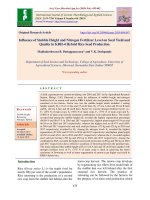


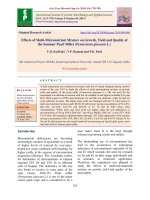
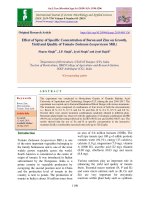
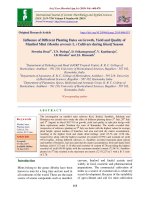
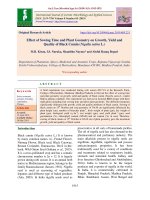
![Effect of fertility levels and stress mitigating chemicals on nutrient uptake, yield and quality of mungbean [Vigna radiata (L.) Wilczek] under loamy sand soil of Rajasthan](https://media.store123doc.com/images/document/2020_01/09/medium_ftp1578562755.jpg)
